CityCenterDC takes up four square blocks in the heart of downtown Washington. The mixed-use development was built atop the rubble of the former Washington Convention Center, a brutalist concrete structure that was demolished in 2004. The hulking complex had been a testament, of sorts, to an era when Washington wasn’t just America’s capital but its murder capital as well. A college friend once told me that his father, who worked as a surgeon in D.C. during this era, became one of America’s leading experts on AK-47 wounds.
These days, private security officers patrol CityCenterDC’s glittering sidewalks. Hermès, Dior, and Louis Vuitton boutiques—each one displaying different $5,000-plus handbags—face each other, separated by pedestrian-only streets. You can live in CityCenterDC, too. Apartments in its high-security complexes rent for between $2,900 and $4,300 a month. Former Attorney General Eric Holder bought a condo there for $1.5 million in 2014. Among his new neighbors is Missouri’s Democratic Senator Claire McCaskill, who dropped $2.7 million on her own condo unit earlier that year.
Beyond the District, in a tony Virginia suburb, an Easter egg roll hosted by a luxury jeweler hides $8,000 worth of gemstones inside its eggs. A Washington Post headline moans: “The $1,000 date night: Has D.C.’s tasting menu culture hit a tipping point?” The region now boasts six of the nation’s ten wealthiest zip codes. And who knows what kind of decadence the Trump administration is likely to bring.
Today’s Washington is a far cry from what it was in decades past—the riot-scarred open-air drug markets and the sleepy suburban bedroom communities. The city hit rock bottom in the latter half of the 20th century—and it fell hard. Huge swaths of D.C. burned in the riots that tore through American cities in 1968. In the 1980s and 1990s, the city was devastated yet again, this time by the crack epidemic and the War on Drugs. In his 2014 memoir about the District’s bad old days, Ruben Castaneda, who covered the Shaw neighborhood as a Washington Post crime reporter, describes the state of things.
“In front of the abandoned Wonder Bread bakery, there were probably six to 10 drug dealers, slingers, just loitering in front of the building,” he wrote. Today that abandoned Wonder Bread factory is a WeWork space.
From Buffalo to Portland, America’s crumbling industrial centers have undergone “renewals” in recent years, reversing the decades of white flight that took place during the mid-20th century. A few cities—namely San Francisco, New York, and Washington—have changed more drastically, transfigured by massive infusions of wealth from specific industries. For San Francisco, that industry is tech. For New York, it’s finance. But D.C.’s cash infusion has come from two industries: the government contracting sector and the influence peddling sector.
Talkin’ bout money, money, money
Today’s booming contracting sector has its roots in the Reagan years. The president’s monomania for “small government” manifested, in part, in policies that favored outsourcing the work once done by full-time government employees to private contracting firms.
“The $1,000 date night: Has D.C.’s tasting menu culture hit a tipping point?”
“Hiring became secondary to contracting, and more and more public projects were outsourced to private firms,” writes New York Times Washington bureau reporter Annie Lowrey.
President Bill Clinton picked up where Reagan left off, cutting some 250,000 government jobs. Yet these personnel cuts didn’t necessarily add up to increased government savings—spending actually rose as the private sector became responsible for more and more government work. After all, Lowrey explained, “Those contractors often came at a bloated cost.”
But it was the Bush administration’s so-called war on terror—and the creation of the Department of Homeland Security in the wake of the attacks on September 11, 2001—that really brought home the bacon for Washington. The White House needed troops, data, and civilian manpower for its Middle Eastern adventures, and it looked to the private sector for help. As a result, contractors found their way into some of the government’s more covert operations—including bulk-data collection and the drone war. The federal budget expanded accordingly, to the tune of around $1 trillion.
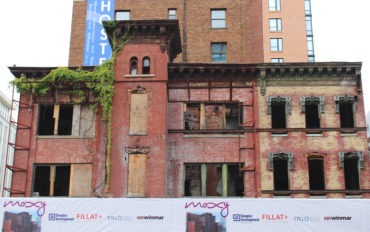
A relic of a previous era in fast-changing downtown D.C. Image Credit: Colette Shade.
Some of the private beneficiaries of this public budget increase include Booz Allen Hamilton, which contracts with the National Security Agency, and once counted Edward Snowden among its employees. The Virginia-based Science Applications International Corporation—SAIC for short—makes military vehicles and was recently the recipient of a U.S. Navy training contract that seems to involve the creation of virtual reality technology. General Dynamics makes, among other things, the Predator drones that have become an all-too-common sight in the skies above parts of the Middle East and Africa. And according to a 2010 Washington Post article, “an estimated 854,000 people, nearly 1.5 times as many people as live in Washington, D.C., hold top-secret security clearances.” That’s a market large enough for a company called ClearanceJobs.com, which advertises heavily inside the Washington Metro, to flourish.
Meanwhile, another industry—one crucial to the well-being of our inflated military-industrial complex—has taken off: influence peddling—a.k.a. lobbying. Business here is also booming; as Lee Fang writes at The Nation, it is now a $9 billion industry. Oddly, while influence peddlers essentially practice lobbying, they usually aren’t registered as such.
“Rather than using the L-word to describe what they do, many lobbyists prefer the more banal rubric of ‘government relations’ or ‘government affairs,’” explained Fang.
The industry has built its own revolving door for government bureaucrats and elected officials. Tim Pawlenty, the former Republican Governor of Minnesota and onetime presidential hopeful, brings in $1.8 million a year lobbying for the financial industry. Former Democratic Senator Chris Dodd made $3.3 million in a single year working for the Motion Picture Industry of America. Catherine Novelli brought in over $7.5 million working for Apple. And Deborah Lee James, who served as vice president for government affairs at SAIC before her 2013 nomination as Secretary of the Air Force, earned nearly $1 million that year.
Chocolate City and its vanilla suburbs
D.C.’s big money has also transformed its suburbs. Since the 1980s, suburban subdivisions have been gobbling up rural Virginia farmland miles away from the city. Some of these developments are what might be termed middle class—prefabricated ranchers and the like—but others are truly shocking manifestations of nouveau contracting wealth. Mike Lofgren—a former Republican Congressional aide who has become something of a critic of the contemporary right—has referred to “the McMansion as symbol of the Deep State.” Nowhere is this more apparent than the Northern Virginia town of Great Falls—home of the gemstone Easter egg hunt—whose real estate market is chock-a-block with new $10 million McMansions aping the style of French chateaux and Italian palazzi.
Great Falls was not always a playground for the nouveau riche and their offspring. McLean—its neighbor to the west—was tony, but in a subdued, old-money way. Among its more distinguished houses was Hickory Hill, a white brick Georgian once owned by the Kennedy family. Over the past three decades, Great Falls has become synonymous with the type of contracting money that dwarfs the likes of the Kennedys. In 2013, tech millionaire Alan J. Dabbiere bought Hickory Hill for $8.2 million, disposing of the home’s hand-carved molding and some of the yard’s old-growth trees.
The distinction between urban and suburban luxury seems to be one based largely on convenience. The
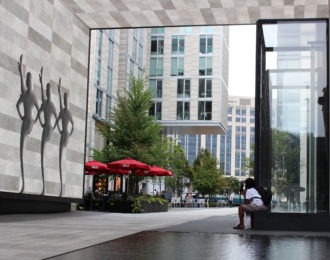
Scenes from CenterCityDC: A water feature, a giant video installation and Daniel Bolud’s DBGB Kitchen and Bar. Image Credit: Colette Shade.
security contracting industry operates mainly out of Northern Virginia—proximate to the Pentagon and the C.I.A. headquarters—while the influence peddling industry prefers K Street—close to Capitol Hill. A McMansion in Great Falls makes sense for an employee of SAIC, while CityCenterDC would be more convenient to an employee of a downtown lobbying firm.
But the aesthetic differences between Northern Virginia and the District of Columbia also hint at differences in values and worldview. The single-family McMansions of Great Falls—isolated on winding, intentionally confusing roads, surrounded by forest, guarded by gates and elaborate security systems—offer an aesthetic of radical individualism, even paranoia. On the other hand, CityCenterDC offers one of warm faux-openness. It seems to market itself as a place for people who love cities, but would prefer their neighbors to be a diverse group of high-income graduates of elite colleges. It is a place that promises both “vibrancy” and private security to prevent the local homeless from loitering in front of Dolcezza Gelato.
But the suburbs aren’t all extreme wealth, or even middle class dronery. Drive east from Great Falls on Virginia’s Route 7, and you’ll find yourself in another type of suburb. In Falls Church, Virginia, you’ll drive past strip malls crammed with Vietnamese pho joints, Salvadoran pupuserias, Afghan restaurants, Western Unions, and immigration lawyers, Bolivian bakeries, and Ethiopian grocery stores. You’ll pass garden apartments and one of the largest mosques in the Washington area. Suburbs like Falls Church and Langley Park, Maryland, have become a refuge from the city’s vertiginous rents. But these suburbs also face new challenges as low-income residents—many in need of local government services—crowd out a wealthier tax base.
D.C.’s suburban sprawl has brought with it another inconvenient consequence: traffic. The Washington area now contends with Los Angeles and Chicago for most congested metropolis in the country. It’s common knowledge among locals that driving should be avoided, if possible, between the hours of 6 a.m. and 11 a.m., and again between the hours of 3 p.m. and 8 p.m. Drives that might take 20 minutes in the middle of the night can take well over an hour in the stop-and-go traffic of daylight.
Bland in D.C.
D.C. has long been painted as a drab city full of dark-suited, lanyard-wearing government drones. This belief stems, of course, from the assumption that government is inherently bloated, stagnant and inefficient. Leaving aside this Reaganesque fallacy, D.C. has long nurtured a unique culture that has nothing to do with bureaucracy.
The trouble with D.C.’s transformation is the parasitic character of the industries that have transformed it.
The city is a hub of black culture. U Street had its own miniature Harlem Renaissance. Duke Ellington and Marvin Gaye are sons of the city, which George Clinton’s Parliament christened Chocolate City in 1975. The city even boasts its own genre of music. Go-go—a percussive, slowed-down style of funk—can be heard on warm days in the residential neighborhoods east of 16th Street, emanating from porches, storefronts and car stereos. The smiling visage of Chuck Brown, “The Godfather of Go-go” can be seen around town, memorialized on murals and T-shirts.
Another part of D.C.’s cultural heritage is its hardcore punk scene. Bands like Bad Brains, Minor Threat and Fugazi were formed in the District, where they played sweaty shows full of slam dancing local teens at venues like St. Stephen’s Episcopal Church in Columbia Heights and the 9:30 Club. When Bad Brains—arguably the ur-D.C. punk band—released its eponymous album in 1982, the cover art featured a black and white image of lightning striking the U.S. Capitol’s dome, set against a bright yellow background.
Like most gentrified cities, D.C.’s cultural heritage has been packaged, commodified and sold back to its
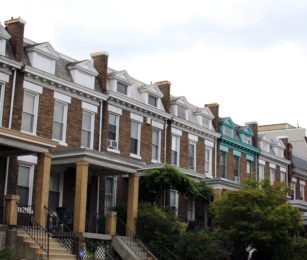
Traditional rowhouses in the Shaw neighborhood. Image Credit: Colette Shade.
residents. Now, discerning Washingtonians can enjoy brunch and happy hour at Marvin’s, a Belgian/Southern restaurant on 14th Street. HalfSmoke, an airy fast casual restaurant “aimed at millennials,” offers gourmet takes on the city’s signature hot dog, conveniently located in quickly-gentrifying Shaw, the neighborhood with the crack market-cum-WeWork.
Meanwhile, many go-go venues have been pushed into the cheaper Prince George’s County, Maryland. The 9:30 Club still stands—Rolling Stone recently named it the best “big room” venue in the United States—but it’s down the street from a Warby Parker outlet and high-end haberdasher Read Wall, which offers $155 button-down shirts. D.C.’s punk and go-go scenes are far from dead. But rising costs of living are a challenge to maintaining any local scene.
Leaving Babylon
The trouble with D.C. isn’t that it has lost some sort of gritty authenticity. It’s good that the city no longer leads the nation in AK-47 wounds from pitched street battles over drug territory. There’s nothing particularly wrong with Marvin Gaye-themed eateries or fancy half-smokes. Even a store selling a $5,000 handbag located across the street from another store selling a different $5,000 handbag isn’t, on its own, objectionable. (That said, it’s certainly disturbing that there’s a market for such products in a country that leads the developed world in child poverty.)
No, the trouble with D.C.’s transformation is the parasitic character of the industries that have transformed it. The defense industry takes money away from things like infrastructure and universal social programs, and diverts it toward predator drones to bomb civilian weddings in Afghanistan. Meanwhile, the lobbying industry has transformed the country’s political system into something resembling an oligarchy.
Most troubling is the capacity of D.C.’s two big industries to work together in a relationship of mutual benefit. Will they ossify into a permanent class? Hard to say. But if you want a vision of what that future might look like, imagine Hermès, Dior, and Louis Vuitton stores, all across from each other, stamping on a city—forever.
Colette Shade is a writer living in Baltimore.



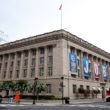

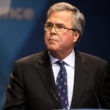

What are you talking about with your Falls Church comments. At the 2010 Census, the median income for a household in the city was $120,000, with 4% of the population below the poverty line, the lowest level of poverty of any independent city or county in the United States.